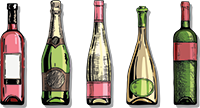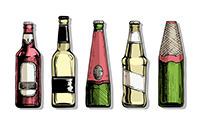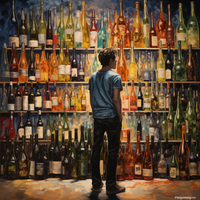Wine and Beer Bottles: Why So Many Different Styles?
Posted by Matteo Lahm on 31st Jul 2023
Home beer and winemakers typically reuse bottles. It is economical but, if you have the means, you might want to consider upping your variety. Bottle shapes, colors, and sizes are more than just aesthetic and stylistic choices. Though that is most of it, bottle shapes and colors not only give differential cues for different types of wines and beers, there are some functional reasons as well that may come as a surprise. Color is more consequential than shape but form is not irrelevant either. Let’s explore why different bottles are used so you can make more informed choices for how you bottle your beer and wine. If you like to give bottles as gifts, the right bottle is a nice finishing touch to represent your skill and hard work.
Wine Bottle Shapes

There are three shapes for dry wines and two are almost the same bottle with slight variations. The most common standalone is the tall and narrow Bordeaux bottle. This bottle shape is used for many red and white wines. It is the most functional bottle shape and easiest to store. However, there is also a functional reason for its use. It allows the wine to simultaneously age more quickly and open more slowly due to the narrow neck. With reds this is especially beneficial. You want the wine to oxygenate more slowly to soften the tannins and preserve more of the flavor. It also keeps sediment away from the cork.
The Burgundy bottle is a shorter, wider bottle that is used for Chardonnay and Pinot Noir. This bottle shape better preserves the delicate flavor and aroma of the wine. The bottle's thicker glass walls, narrow neck, and rounded shoulder help to keep the wine from being exposed to too much air, allowing it to open more gracefully and age more slowly. The bottom of the bottle is usually flat.
Last but not least, the Rhone bottle is a slightly narrower and taller version of the Burgundy bottle. Its neck is slightly wider, bottom slenderer with a higher shoulder. It is the signature shape for wines from the Rhone valley. This minor difference makes the Rhone bottle perform more like the Bordeaux for aging and oxygenation but looks more like the Burgundy.
For sparkling and sweet wines, there are also two primary styles. The Alsace bottle is like the Rhone and Burgundy but is the tallest and slenderest of the three. It is used for sweet wines such as Riesling and Gewürztraminer. The shape of the bottle is beneficial to maintain crispness and slow oxygenation. Finally, the Champagne bottle is at the other end of the spectrum of this bottle style. It is a tall, heavy bottle with the widest belly and thickest base. This bottle shape is used for sparkling wines due to its ability to withstand the high pressure from the carbonation.
Beer Bottle Shapes

When it comes to beer bottles, there are a few different shapes that are used and their designs effect the pour. The most common shape is the long-neck bottle, which is used for both ales and lagers. This bottle shape allows for the beer to be poured easily and prevents the beer from becoming overly carbonated. The stubby bottle is a shorter, wider bottle that is used for ales and stouts. This bottle shape helps to keep the beer fresher for a longer period of time due to its smaller surface area. The swing-top bottle is a wide-mouthed bottle that is used for beers that require a different type of pour, such as Belgian beer or wheat beer. This bottle shape allows for a slow and controlled pour, which can help to create a better head and improve the presentation of the beer. Finally, the growler is more universal. Its large, jug-like shape can be used for all beer types without the need for additional packaging. The only downside is that beer loses carbonation with headspace. If you pop open a growler, it is best to finish it.
Bottle Colors
The color of a wine or beer bottle can also be used to differentiate between different types of wines and beers. However, color is often even more important than shape. For example, you’ve probably noticed that red wines are typically bottled in green or brown bottles, while white wines are usually bottled in clear or frosted bottles. Light is problematic with reds. Since they are more suitable for aging, you want your reds in bottles that blocks UV rays as red wines are more prone to oxidation. For whites, showing off the color is paramount. So clear bottles are a compromise. Though whites are also subject to the same oxidation issues as reds, they are less likely to be aged. Color and clarity are also more evident. So it is important to be able to see the wine through the glass.
Beer bottles can also be colored, and the color can indicate the type of beer that is inside. For example, a green bottle usually indicates a pilsner, while a brown bottle usually indicates a lager or stout. Lighter beers often come in clear bottles to show off their golden hue just like white wines.
Conclusion
Bottle shape, size, and color can all play an important role in wine or beer. They allow for different types of pouring, aging, and storage. Different colors are used to indicate the type of wine or beer, and to protect the wine from oxidation. All of these characteristics serve a function, and as you venture into more variety in your beer and winemaking, you can choose your bottles accordingly. Good luck!

